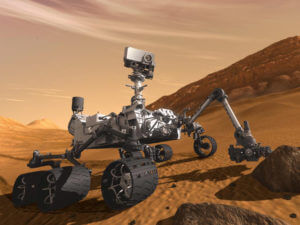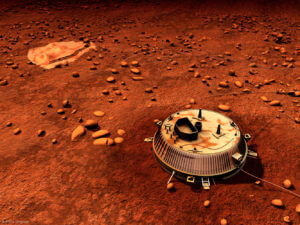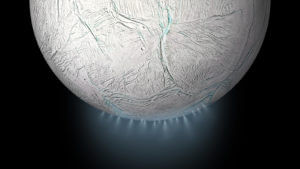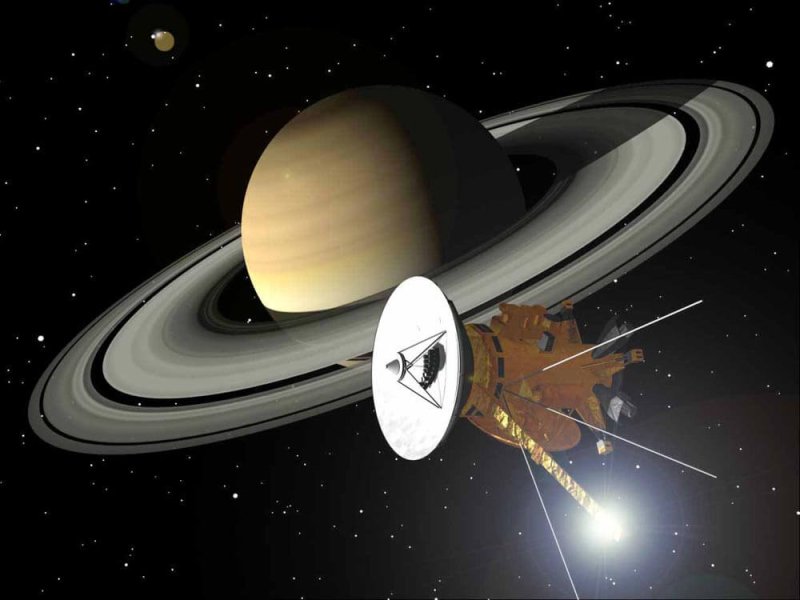Space agencies and planetary scientists around the globe are combing through data from big, multi-instrument probe missions in a careful step-by-step search for extraterrestrial life — with an emphasis on environment habitability. They’re seeking a better understanding of the chemical and physical nature of various planets and moons that could be targeted for future life-searching missions. This is happening at a time when NASA’s car-sized Curiosity rover is easing gradually up a Martian hill with no end in site, and in the aftermath of the end of a 20-year voyage of the Saturn-exploring Cassini probe.
Though one craft is still going and the other has said farewell, the work at Mars and Saturn is fairly similar. In both instances, exploration craft have been operating for many years, producing major discoveries of astrobiological import. Scientists are hoping to find life as we know it — meaning organisms that depend on organic (carbon-based) chemistry, and that require water — somewhere in our Solar System. Nobody expects intelligent life. Instead, the search is focused on the prospect for single celled life. And maybe in the oceans of an ice-covered world, like Saturn’s moon Enceladus, multicellular life forms are plausible.
One big difference between the Martian and Saturnian missions, however, is that native life discovered in the latter case is likely to be unrelated to life on Earth. Deep down in the ocean beneath the icy surface of Enceladus, or in the ocean of Jupiter’s moon Europa, the presence of life would represent an independent origin from the web of life that inhabits Earth. In contrast, when it comes to Mars, it’s quite plausible that we’ll find that native life forms there will be distant cousins of Earth’s organisms, that the life of both planets began from a common origin from non-living chemistry. That’s because rock material — tons of it– transfers each year between the surfaces of Earth and Mars in a process that has been happening for billions of years. It’s also plausible that Martian life, if it exists, represents an independent origin from that of Earth, but we won’t know until we find such life and analyze it.
What NASA’s Curiosity rover told us

NASA’s Mars Science Laboratory (MSL) mission includes, Curiosity, the largest and most capable robotic rover ever landed on the Red Planet. Curiosity is exploring the Gale crater, which held liquid water for long periods between 3.3 billion and 3.8 billion years ago. Evidence that the crater was home to rivers and streams came in a couple of years ago. What’s new is a study, published in the journal Science, by researchers at the State University of New York at Stony Brook. Numerous data from Curiosity‘s instruments have been accumulating for the taking, and the Stony Brook team set out to extract information on specific minerals within the rocks at different locations and depths in the crater zone, and the oxidation states of those minerals. The Stony Brook analysis revealed climate change — from warmer wetter conditions in the distant past to dryer colder conditions, which adds weight to the possibility that the region has been a home to microorganisms.
The analysis also revealed redox stratification –differences in oxidation states between different levels, specifically more oxidized along the crater’s edges and less oxidized lower down. The researchers are interpreting the find to mean that far in the past, when the Gale crater held a large lake, the upper regions of the water constituted a high oxygen zone that would have been friendly to aerobic life forms, while the deeper parts of the lake would have be favorable to anaerobic forms. This means there could have been a diversity of different types of life, which is to say a healthy ecosystem.
Cassini: The mission that went into double overtime
Launched in 1997, the Cassini mission was operated jointly by NASA, the European Space Agency (ESA), and the Italian Space Agency (ASI). The mission’s full name was Cassini-Huygens, because it included two craft. Italian astronomer Giovanni Domenico Cassini (1625-1712), who discovered four of Saturn’s moons and the divisions between the planet’s rings, is the namesake of the larger craft, which orbited Saturn from 2004-2017. The mission also included the ESA Huygens probe. It was named for Christiaan Huygens, the Dutch astronomer who discovered Saturn’s largest moon, Titan, where the probe landed successfully in 2005.

The original mission plan for Cassini was to last until June 2008 — four years after entering orbit around Saturn. However, since all systems were go, with plenty of fuel for propulsion and plutonium for electricity, the mission was extended to 2010, but it wouldn’t end there either. With mountains of discoveries about Saturn and its moons in the rear view mirror and numerous data still to be analyzed, and still plenty of propellant in the fuel tanks, mission planners gave Cassini the green light for an additional seven years.
In terms of the engineering, the design requirements needed only to enable the original projected mission duration to 2008, but not until nine years later, this past September, did controllers steer Cassini into Saturn’s atmosphere to end the mission. That was simply because the fuel was about to run out, but everything was still working just fine. (One can’t help but wonder if some sort of “Scotty Effect” was operating, wherein the engineer –accidentally on purpose– underestimates how well, or how long, something that he designed will work, so that everyone will be amazed later.)
Habitability of the environment
Like the MSL on Mars, the mission of Cassini-Huygens in the Saturn system has included characterization of the chemistry of the environment, and the physical conditions affecting it. In the case of Saturn, the spotlight for the search for extraterrestrial life is not the planet itself, but the planet’s moons. In 2005, during its descent to the surface of Titan, the Huygens probe detected hydrocarbons in the moon’s thick atmosphere, including methane rain, and lakes and seas of methane and ethane. These things had been suspected prior to the mission, and in making such finds, the Huygens’ instrument package provided evidence for the idea that Titan’s environment is like that of Earth billions of years ago, just before the origin of life. Titan has what astrobiologists call prebiotic chemistry.
Like Huygens, the Cassini probe also studied Titan’s prebiotic chemistry. During its thirteen years orbiting Saturn, Cassini also flew by Saturn’s other moons, including Enceladus, a world that is covered in water ice. Cassini confirmed the presence of a global ocean under that ice, and also discovered plumes of liquid spewing up from cracks in the ice at the south pole, like the geysers at Earth’s Yellowstone Park. At Enceladus, however, the geyser plumes shoot far into space. Taking measurements of the plumes, Cassini demonstrated that they consisted of water, plus, over the years, the craft’s instruments have been able to tell us that those plumes contain organic molecules — called the “stuff of life” by the late astronomer Carl Sagan. Based on this finding, scientists knew that Enceladus had two major requirements to support life — water and material from which to make organisms and food.
Along with water and organic matter, a world that harbors life also needs an energy source that organisms harness to synthesize food and energy molecules. Vital to that requirement, Cassini detected very tiny rocks in the water plumes, suggesting that hot water is flowing somewhere down in the ocean, like the hot water in the hydrothermal vents that support life forms at the bottom of Earth’s oceans in the absence of sunlight. And last but not least, something that happened earlier this year, just a few months before Cassini was sent to burn up in Saturn’s atmosphere, the instruments detected in the plumes the energy source itself: hydrogen.

Putting all of this together, we can say that Enceladus is “habitable;” it has all the ingredients for life. We found this out through a long, patient process. And so now, with more confidence than would have made sense before, there is a major target in the outer solar system for more sophisticated chemistry instruments, but also a direct life search. The latter means instruments designed to be flown through the plumes of Enceladus and to analyze the water directly for the presence of organisms.
As for Mars, something similar is happening as analysis of the environment is pointing increasingly to the idea that the planet could support life. Back in 1976, a NASA mission called Viking, delivered twin landing probes to two locations on the Martian surface. Each lander carried several instruments designed to study the chemical and physical environment, but also a “biology package” consisting of three experiments to test for the presence of microorganisms in samples of Martian dirt. At both landing sites, the biology experiments gave ambiguous results.
But ambiguity often exists along a spectrum. In science projects that depend on big, expensive ventures such as space missions, it’s common to view and discuss discoveries and insights from a linear perspective. First, one thing was discovered, then something else that built on top of that earlier discovery, and so forth. Of the three Viking biology experiments, one experiment, known as the Labeled Release (LR), produced results that seemed to indicate the presence of microorganisms, but then were dismissed, largely because a positive finding looked inconsistent with various findings about the chemical and physical environment on the Martian surface. To be sure, the LR principal investigator, Gilbert Levin, has maintained for the past 41 years that his experiment actually detected Martian life. Some fraction of the science community has some to agree with some or all of his reasoning. The consensus is still that the LR results of the 1970s are too ambiguous to be counted as evidence of life, but it’s notable that our understanding of the Martian environment and its suitability for life has evolved substantially in the past four decades, because of MSL and other missions that have been on Mars since Project Viking.
Now that we know that the Martian chemical environment could be friendly to living forms, the scientific payoff from sending a direct life search experiment to Mars could be far less ambiguous compared with the Viking experience. But, perhaps due to the Viking experience — and also to the possibility that any ambiguity about an issue as game-changing as the discovery of life on another planet could endanger public support for such missions — space agencies around the planet have been taking a careful approach, both in the inner and outer Solar System.
David Warmflash is an astrobiologist, physician and science writer. BIO. Follow him on Twitter @CosmicEvolution.































